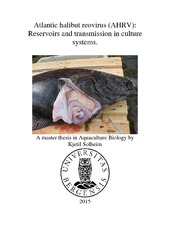| dc.contributor.author | Solheim, Kjetil | |
| dc.date.accessioned | 2016-01-13T17:29:36Z | |
| dc.date.available | 2016-01-13T17:29:36Z | |
| dc.date.issued | 2015-11-27 | |
| dc.date.submitted | 2015-11-27 | eng |
| dc.identifier.uri | http://hdl.handle.net/1956/10954 | |
| dc.description.abstract | The ability to expand within the aquaculture industry is essentially based on reliable production of healthy juvenile fish. In 2013 a new aquareovirus was found to be associated with high juvenile mortality at a Norwegian Atlantic halibut production site, but the source of the virus was not identified. Feed and water intake had been tested with negative results. The aim of this study is to test the halibut brood fish as a possible source for the virus. The brood fish are stripped several times during their life time which means that it is necessary to develop non- lethal sampling methods for screening with respect to presence of virus. The Atlantic halibut reovirus (AHRV) is known to replicate in the liver and pancreas tissues of the halibut and large amounts of virus have also been detected in the kidneys. This means that shedding of the virus through faeces or urine could contaminate the eggs during stripping. A method of anal swabbing was developed for testing of faeces and urine for presence of the AHR virus. In addition, eggs and milt from each batch liberated from the brood fish were tested for presence of the virus. Halibut larvae produced during the study period suffered a disease outbreak associated with both AHR virus and Infectious pancreatic necrosis virus (IPNV). The IPN virus is also known to replicate in liver, pancreas and kidney of the halibut, which mean that the same approach for identifying possible virus positive brood fish could be used for both viruses. The ovary fluid from a female halibut tested positive for AHRV and IPNV and the tanks containing larvae hatched from eggs from this female suffered high mortalities. The female brood fish halibut was killed and tissues taken for analyses which revealed presence both AHRV and IPNV in the posterior kidney. Sequencing of segment 10 from AHRV present in both the larvae and the brood fish gave 100% identical sequences which suggest a common origin of the two viruses. The screening of the broodstock halibut may be an essential part of securing healthy juvenile halibuts in the future. | en_US |
| dc.format.extent | 1704842 bytes | eng |
| dc.format.mimetype | application/pdf | eng |
| dc.language.iso | eng | eng |
| dc.publisher | The University of Bergen | en_US |
| dc.subject | atlantic halibut reovirus | eng |
| dc.subject | AHRV | eng |
| dc.title | Atlantic halibut reovirus (AHRV): Reservoirs and transmission in culture systems. | en_US |
| dc.type | Master thesis | |
| dc.rights.holder | Copyright the Author. All rights reserved | en_US |
| dc.description.degree | Master i Havbruksbiologi - Generell havbruksbiologi | en_US |
| dc.description.localcode | MAMN-HAV | |
| dc.description.localcode | HAV399 | |
| dc.subject.nus | 751599 | eng |
| fs.subjectcode | HAV399 | |
